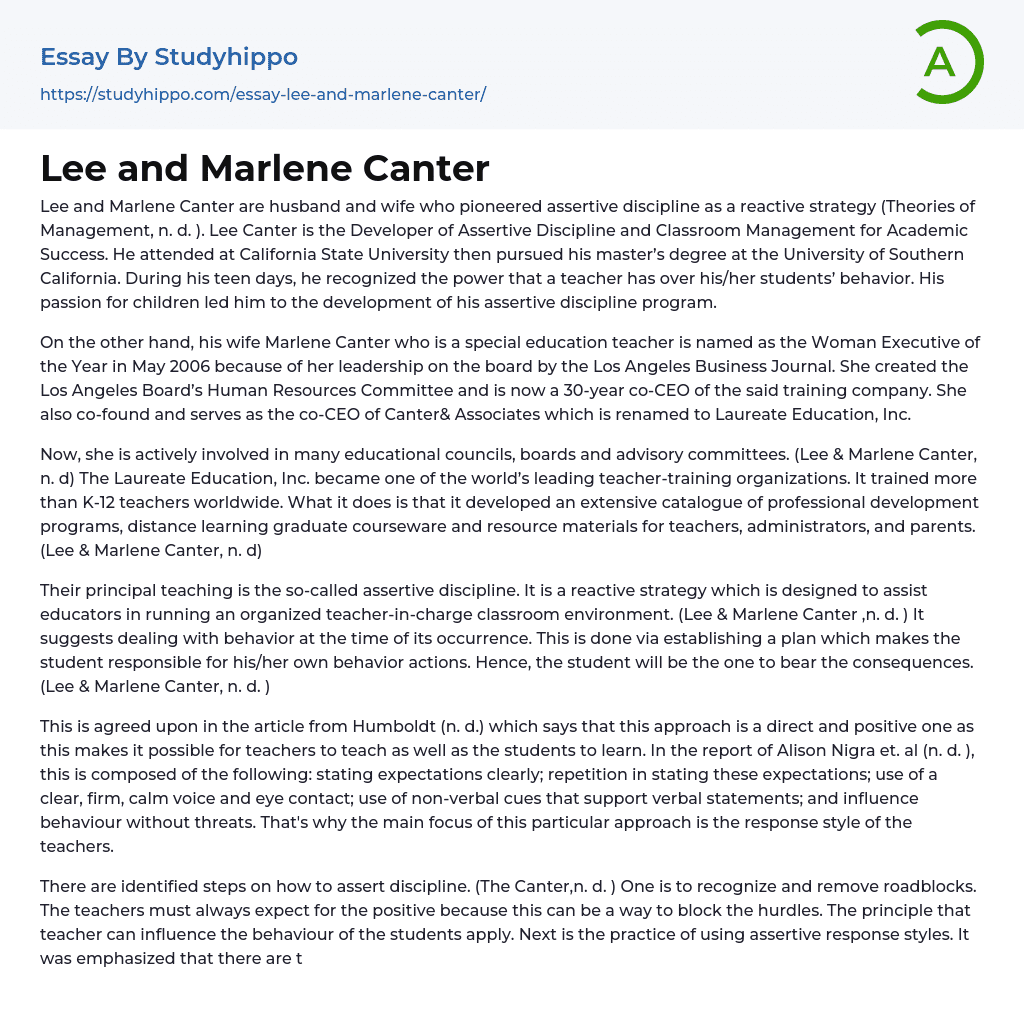Lee and Marlene Canter are husband and wife who pioneered assertive discipline as a reactive strategy (Theories of Management, n. d. ). Lee Canter is the Developer of Assertive Discipline and Classroom Management for Academic Success. He attended at California State University then pursued his master’s degree at the University of Southern California. During his teen days, he recognized the power that a teacher has over his/her students’ behavior. His passion for children led him to the development of his assertive discipline program.
On the other hand, his wife Marlene Canter who is a special education teacher is named as the Woman Executive of the Year in May 2006 because of her leadership on the board by the Los Angeles Business Journal. She created the Los Angeles Board’s Human Resources Committee and is now a 30-year co-CEO of the said training company. She a
...lso co-found and serves as the co-CEO of Canter& Associates which is renamed to Laureate Education, Inc.
Now, she is actively involved in many educational councils, boards and advisory committees. (Lee & Marlene Canter, n. d) The Laureate Education, Inc. became one of the world’s leading teacher-training organizations. It trained more than K-12 teachers worldwide. What it does is that it developed an extensive catalogue of professional development programs, distance learning graduate courseware and resource materials for teachers, administrators, and parents. (Lee & Marlene Canter, n. d)
Their principal teaching is the so-called assertive discipline. It is a reactive strategy which is designed to assist educators in running an organized teacher-in-charge classroom environment. (Lee & Marlene Canter ,n. d. ) It suggests dealing with behavior at th
time of its occurrence. This is done via establishing a plan which makes the student responsible for his/her own behavior actions. Hence, the student will be the one to bear the consequences. (Lee & Marlene Canter, n. d. )
This is agreed upon in the article from Humboldt (n. d.) which says that this approach is a direct and positive one as this makes it possible for teachers to teach as well as the students to learn. In the report of Alison Nigra et. al (n. d. ), this is composed of the following: stating expectations clearly; repetition in stating these expectations; use of a clear, firm, calm voice and eye contact; use of non-verbal cues that support verbal statements; and influence behaviour without threats. That's why the main focus of this particular approach is the response style of the teachers.
There are identified steps on how to assert discipline. (The Canter,n. d. ) One is to recognize and remove roadblocks. The teachers must always expect for the positive because this can be a way to block the hurdles. The principle that teacher can influence the behaviour of the students apply. Next is the practice of using assertive response styles. It was emphasized that there are three types of response. They include the assertive, non-assertive and the hostile response (Theories of Management & The Canter, n. d. ).
Assertive teachers are those who clearly and firmly express their needs. Their expectations are positive and they always mean what they are saying. On the other hand, non-assertive teachers do not make their own needs or wants known. They confuse students as they appear
indecisive. Although this type of teachers threatens, the students know that this will not be put into action. Lastly, those that disregard the needs of the students are the hostile teachers. There is always a negative response to students. Unprofessional comments about colleagues are overtly shown.
Next is that teachers should also know how to set limits. The teachers in the first place must be aware of the behaviour that they want to see. Aside from learning the limits, they must also know how to follow through limits. This only means that they themselves know what to do if their expectations are not met. Lastly, the teachers must not dwell with sanctions and punishments alone. They must also provide a positive reinforcement for those who are following them. In this way, other students can be motivated to do more than what the teacher expects.
- Classroom Management essays
- Emergence essays
- Anxiety Disorder essays
- Post-traumatic Stress Disorder essays
- Interpretation essays
- Plagiarism essays
- Analogy essays
- Learning English essays
- Insanity essays
- Peer Group essays
- Classroom essays
- College essays
- E-Learning essays
- Elementary School essays
- Examination essays
- Graduate School essays
- High School essays
- History Of Education essays
- Homeschooling essays
- Kindergarten essays
- Middle School essays
- Public School essays
- School essays
- Single Sex Schools essays
- Special Education essays
- Student essays
- Teacher essays
- University essays
- Vocational Education essays
- Addiction essays
- Anatomy and Physiology essays
- Biodegradation essays
- Cancer essays
- Dental Care essays
- Disability essays
- Disease essays
- Disorders essays
- Health Care essays
- Infectious Disease essays
- Inquiry essays
- Intelligence Quotient essays
- Lung Cancer essays
- Medicine essays
- Neurology essays
- Nutrition essays
- Olfaction essays
- Physical Exercise essays
- Public Health essays
- Sex essays
- Women's Health essays




